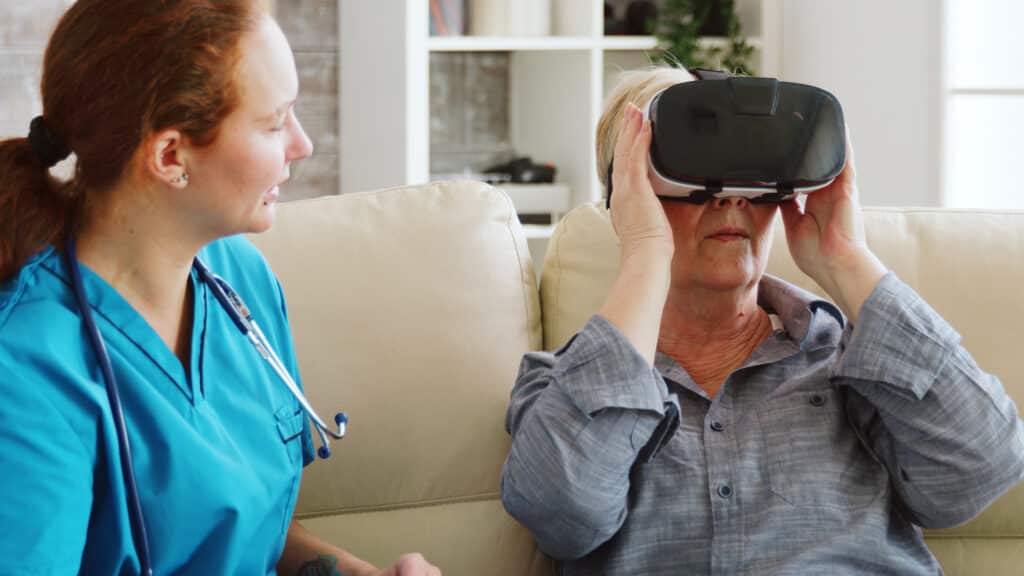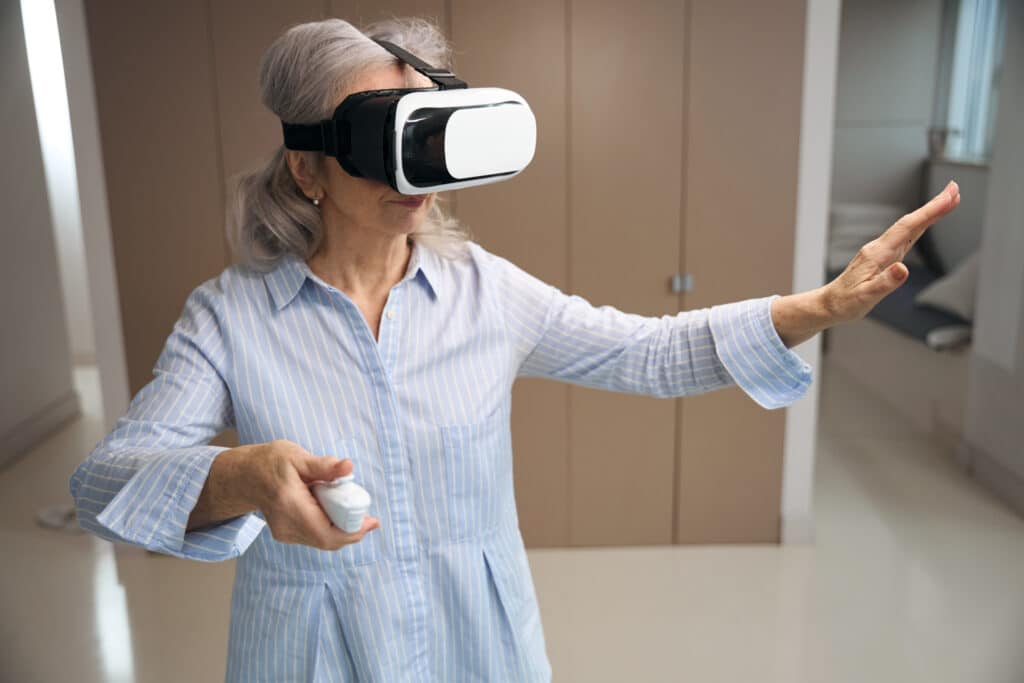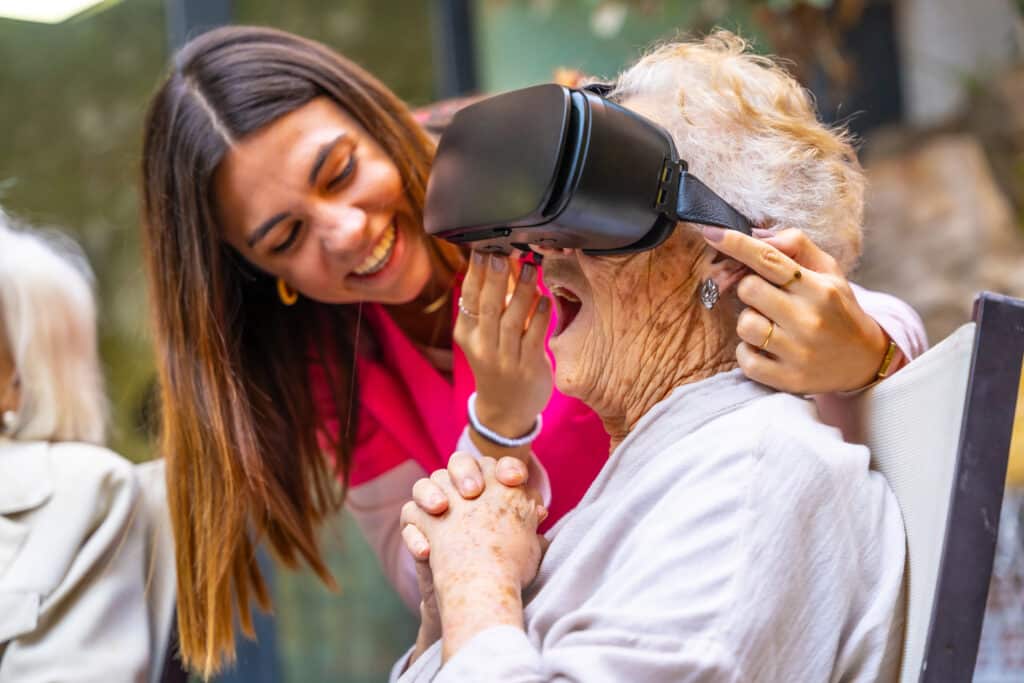Video games have come a long way from their arcade origins. Today, they’re a dynamic tool in healthcare, especially when it comes to gaming in physical therapy and other rehabilitation methods.
Motion-sensing and movement-tracking technology, like the Nintendo Wii and Microsoft’s Kinect, has paved the way for what is commonly referred to as “exergames”—a blend of exercise and gaming.
These systems utilize gestural interaction through wearables or a calibrated camera, turning physical movements into game controls, which is an engaging way to encourage and reward physical activity.
Virtual reality has also become an immersive and integrative tool for simulating outside-the-clinic scenarios. This technology can help patients imagine and even feel what it might be like to walk through a busy city or hike up a mountain in a safe, controlled environment.
The possibilities and benefits of these technologies are infinite, and their use in the clinic is really just beginning. Let’s look at how video games and rehabilitation work together to improve patients’ lives.
The Benefits of Using Video Games in Physical Therapy
Incorporating video games into physical therapy offers an innovative and engaging way to enhance patient rehabilitation. These “exergames” combine traditional exercise with interactive gaming, boosting motivation and commitment through fun and competition.
The real-time feedback provided by these games ensures that exercises are performed correctly, maximizing therapeutic benefits and making therapy sessions more enjoyable.
Here’s a closer look at how exergames are transforming physical therapy:
What Are Exergames?
Exergames is the nickname given to video games that incorporate physical activity into gameplay. They blend traditional exercise routines with interactive gaming elements, making physical activity more engaging and enjoyable.
A prime example is the Wii Fit, which uses a balance board to measure the user’s movements and balance. The board allows users to perform yoga, strength training, aerobics, and balance games, all while receiving real-time feedback on their performance.
Another popular exergame is Dance Dance Revolution, which requires players to step on specific parts of a dance pad in time with the music, effectively turning a workout into a dance-off.3
“Gamifying” Physical Therapy
Gamification is the process of incorporating game-like elements, such as points, levels, and rewards, into non-game contexts.
In physical therapy, gamification taps into our natural desire for achievement and rewards. Improving scores or reaching new levels within a game triggers a sense of accomplishment. This intrinsic motivation can make patients more likely to stick with their therapy routines consistently.
Moreover, these games often introduce elements of competition, either against oneself or others. Competing against previous scores or with other players can create a healthy, motivating challenge.
Patients might strive to beat their personal bests or achieve higher rankings, which adds an extra layer of engagement to their therapy sessions.
Enhancing Engagement and Motivation
One of the significant advantages of integrating video games into physical therapy is the boost in patient engagement and motivation.
Traditional therapy can sometimes feel monotonous. Completing the same exercises day after day can become repetitive and disengaging, especially if a patient is having difficulty seeing their own progress or conjuring up motivation.
I’ve seen this in my practice when patients can become disengaged or bored as they complete their exercises.
Video games add an element of fun and competition, which can transform therapy sessions into something patients look forward to.
Motivation plays a significant role in the success of any rehabilitation program. Instead of perceiving therapy as a mundane—or even a painful—necessity, patients can engage with it in a way that feels more like play.1
Beat Your High Score: Instant Feedback for Patients and PTs

Another advantage is the real-time feedback provided by these games. Traditional physical therapy exercises may not offer immediate insights into performance, making it difficult for patients to know if they are doing the exercises correctly.
Video games can provide instant feedback on variables like movement accuracy, speed, and effort.
For example, if a game requires a patient to reach a virtual target, the system can immediately indicate whether the target was hit, how precise the movement was, and suggest adjustments if necessary.
Immediate feedback helps patients correct their movements on the spot, which is crucial for effective rehabilitation. It ensures that exercises are performed correctly, maximizing the therapeutic benefits and reducing the risk of injury from incorrect movements.
Additionally, tracking progress over time becomes more straightforward with video games. Patients can see visual representations of their improvements, such as graphs or progress bars, which can be incredibly motivating.
This visual tracking makes progress tangible and encourages patients to keep pushing forward. This can be helpful for clinicians as well, highlighting which aspects of the program might need more focus.1,2
Customizing Exergames to Fit Your Needs
Video games in physical therapy are not one-size-fits-all, and that’s for the better. These systems can be customized to fit each patient’s specific needs, providing personalized exercise routines that adapt to the patient’s progress.
This adaptability ensures that patients are always working at the appropriate difficulty level, which can help prevent under- and over-exertion.
For example, a physical therapist can adjust the intensity and type of exercises in the exergames based on the patient’s current capabilities and goals. If a patient is progressing well, the game can increase the difficulty, ensuring continuous positive feedback and improvement.
The integration of video games into physical therapy harnesses the power of fun, competition, and immediate feedback to enhance patient engagement and motivation.
By turning exercise into an enjoyable and rewarding activity, these games help ensure that patients remain committed to their rehabilitation programs, leading to better outcomes and faster recoveries.
A Real Patient’s Experience With Stroke Rehabilitation
As a physical therapist, I once worked with a stroke patient named Jane who suffered from neglect: a condition where she ignored both the left side of her body and the left side of her visual field.
This is not uncommon for a stroke patient to experience, depending on what part of their brain was affected. This impairment made it challenging for her to use her left hand and look toward the left side in space.
Traditional therapy methods had limited success, so we decided to incorporate a video game into her treatment plan.
We used a game designed specifically for rehabilitation, which required Jane to interact with objects on the touch screen by tapping with her hand.
A Personalized Path to Improvement
The game first involved her reaching for and tapping virtual targets with her right hand or fingers that appeared on the left side of the screen. Objects initially appeared slowly, and the targets were large.
As Jane progressed, the game gradually increased in difficulty, requiring more precise movements and quicker responses. Jane was very competitive and got quite into the game—she was always aiming to beat her high score.
Eventually, we were even able to progress her to using her left hand to tap small, moving targets on the left side of the screen.
The game’s immersive and interactive nature captured Jane’s attention and motivated her to engage with her left side more consistently.
Over time, Jane’s ability to use her left hand and acknowledge the left side of space improved significantly, demonstrating the potential of these video games in addressing specific therapeutic goals.
This case highlights the power of video games in rehabilitation, showcasing how they can transform therapy into an engaging and effective experience.
Virtual Reality (VR) in Physical Therapy

Technological advances have continued to evolve as virtual reality has become widely available to the public. Virtual Reality (VR) is no longer a tool of the future. it’s now in practical use in various fields, including physical therapy.
VR provides immersive environments that can simulate real-world tasks or create entirely new experiences, making therapy sessions more relatable and even realistic.
By leveraging VR, therapists can create scenarios that help their patients improve mobility, strength, and coordination.3
How VR Enhances the Physical Therapy Experience
If you were to experience VR in a PT session, you might not know what to expect. However, VR provides innovative tools to make your PT session more engaging and fun!
VR Creates a More Fun & Less Pain-Oriented Experience
Virtual reality technology can create immersive, engaging environments that can distract patients from their pain and make therapy sessions more enjoyable.
It can transform sometimes mundane exercises into an adventure by allowing patients to perform them in a virtual park, on a serene beach, or even in outer space.
Changing the exercise to an immersive experience also helps reduce pain perception. Engaging visuals and interactive elements easily capture your attention and draw focus away from discomfort.
VR Increases Variety And Engagement
VR can offer a level of immersion that traditional therapy methods cannot. VR headsets and controllers simulate real-world movements and scenarios. This novel experience provides patients with a sense of presence and immersion that can enhance their therapy experience.
This immersion can lead to increased motivation and effort. In short, you will be more likely to engage fully in the exercises when you are part of an interactive and enjoyable experience.
Finally, the ability to customize and adjust the virtual environments to suit your needs and preferences can further enhance VR’s therapeutic benefits.
How VR is Used in Rehabilitation Settings

As technology advances, so do the uses of VR in rehabilitation.
In recent years, advanced VR systems like the Oculus Rift have been utilized to create tailored VR exercises that are becoming more widely available to patients like you.
Simulating Walking and Balance
For example, patients recovering from lower limb injuries can walk through a virtual forest, where they are required to reach and bend to pick up virtual objects such as flowers or fruits.
This activity dynamically and engagingly improves their range of motion, strength, and coordination. It might also feel more interesting than walking across the clinic floor gathering cones.
Balance and stability training can also be enhanced through virtual reality. Patients might be asked to balance on a virtual tightrope, maintaining their equilibrium while navigating a visually stimulating and challenging environment.
The virtual environment can be adjusted to gradually increase the difficulty level, ensuring that patients are consistently challenged and can progress at their own pace.
VR for Cognitive Rehabilitation
For patients who have suffered from strokes or traumatic brain injuries, VR can offer cognitive tasks that seamlessly integrate with physical movements.
For instance, patients might navigate through a virtual city, solving puzzles and performing tasks that require both cognitive and physical engagement in a busy environment.
This dual-task approach can help improve overall cognitive function while simultaneously addressing physical rehabilitation goals. Practicing navigating through a city through VR allows them to do so in a safe, controlled environment and can even help prepare a patient for an upcoming trip to a busy area!
Improved Metrics for Clinicians
Incorporating VR into physical therapy enhances the therapeutic experience and provides therapists with valuable data on patient performance.
VR systems often include tracking and analytics features that monitor patient movements, progress, and adherence to the therapy program. This data can be used to tailor future therapy sessions, making them more effective and personalized to the individual patient’s needs.
By integrating VR into rehabilitation, therapists can offer a more holistic and enjoyable approach to therapy, ultimately improving patient outcomes and satisfaction.
Long-Term Benefits
Making therapy more fun and engaging can help patients stay motivated and stick to their routines, leading to better results and faster recovery times.
Using video games and VR in therapy can also help reduce healthcare costs by making treatments more effective and reducing the number of visits needed. As these technologies become more affordable and widely used, they have the potential to transform rehabilitation, making it better for everyone involved.
Drawbacks of Gaming in Physical Therapy

While using video games and virtual reality (VR) in physical therapy has many benefits, it’s not perfect for everyone.
User Limitations & Concerns
One big issue is that not everyone has access to the needed technology, like VR headsets and gaming consoles. This can create a gap where some patients get advanced treatment while others miss out.
Another concern is that some patients, especially older adults, might be hesitant to use new technology. They might find it intimidating or worry that it’s too complicated. Making the technology easy to use and providing clear instructions can help ease these fears.
Making It Work
For video games and VR to be effective in physical therapy, both therapists and patients need proper training. Therapists should know how to set up and use the equipment and customize it for each patient’s needs.
Patients need hands-on help to get comfortable with the technology. Initial training should teach them how to use the controllers and navigate the virtual environments. When patients feel confident with the tech, they get more out of their therapy sessions.
Ongoing research and feedback from users are crucial for improving these tools. Developers need to know what works and what doesn’t to make the technology better and easier to use.
Collaboration between tech developers, healthcare professionals, and researchers is key to making sure these tools meet everyone’s needs.
Looking Ahead
The future of video games and VR in physical therapy looks bright. As VR technology improves, it will offer higher-quality visuals and more natural interactions, making therapy even more engaging and effective.
New developments like haptic feedback, which lets users feel virtual objects, are also on the horizon. This can make exercises feel more realistic and beneficial.
For example, a patient could feel the firmness of a virtual ball when practicing grip strength or sense the shifting surface of a virtual tightrope when working on balance.
Key Takeaways
- Video games have grown from simple arcade entertainment to useful physical therapy and rehabilitation tools.
- Technologies like the Nintendo Wii and Microsoft Kinect have created “exergames” that combine exercise with gaming.
- Exergames make therapy more fun by mixing traditional exercises with interactive games. They provide immediate feedback to ensure exercises are done correctly and safely.
- Adding game elements like points and rewards to therapy can motivate patients to stick with their routines by making the experience more engaging.
- Virtual reality (VR) can create real-life scenarios in a controlled environment, making therapy more interesting and helping patients practice activities safely.
- Exergames and VR can be customized to fit each patient’s needs, offering personalized exercises that adapt as they progress.
- Proper training helps both therapists and patients feel comfortable and confident using the technology.
- Some patients and clinics may have difficulty accessing the necessary technology, and some might be hesitant to use it.
- Future improvements, like feeling virtual objects, will make VR exercises even more realistic and beneficial, helping patients stay motivated and achieve better results.
References
- Lohse, K., Shirzad, N., Verster, A., Hodges, N., & Van der Loos, H. M. (2013). Video games and rehabilitation: using design principles to enhance engagement in physical therapy. Journal of neurologic physical therapy, 37(4), 166-175.
- Primack, B. A., Carroll, M. V., McNamara, M., Klem, M. L., King, B., Rich, M., … & Nayak, S. (2012). Role of video games in improving health-related outcomes: a systematic review. American journal of preventive medicine, 42(6), 630-638.
- Pedraza-Hueso, M., Martín-Calzón, S., Díaz-Pernas, F. J., & Martínez-Zarzuela, M. (2015). Rehabilitation Using Kinect-based Games and Virtual Reality. Procedia Computer Science, 75, 161-168. https://doi.org/10.1016/j.procs.2015.12.233






